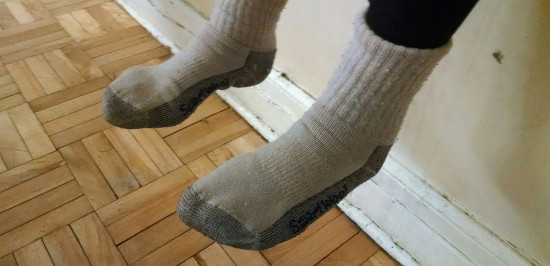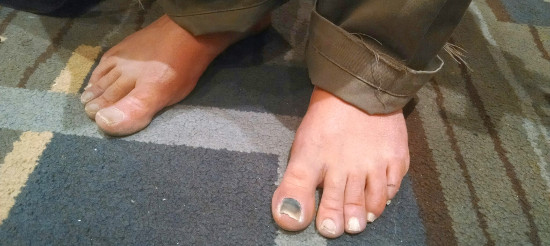Choosing Contra Dance Shoes |
March 18th, 2014 |
| contra, shoes |
(As a contra dance organizer I like it when people bring shoes to change into because then they're less gritty, which is better for the floor and for other dancers' shoes. But for this it doesn't matter what shoe you wear, and you can get much of the same effect by brushing your shoes when you come in.)
Style aside, [1] there are big functional differences between the different shoes you see people wearing. Here are the main questions, in roughly descending order of importance:
- How slippery do you like your shoes?
- In our daily lives most of us wear shoes that are pretty grippy. We mostly use our shoes for walking, and you don't want your shoes to slide along the ground. Contra dancing is different: during the swing it's very helpful to have the toe of your right shoe slide along because this reduces the twisting force on your right knee. It also can be fun to have slippery shoes for other parts of the dance, allowing easier twirls and sliding into place. The downside of these shoes, though, is that you have less control over your movement and it's easier for your feet to slide out from under you. There's a wide variety of preferences here, from "sneakers are great" to "if I dance in anything but very slippery shoes I hurt later."
- How much cushioning do you want?
- When you put your foot down, do you want your shoe to absorb the shock? Some people like the feeling of being close to the floor while others want to protect their joints. [2]
- Do you want to make noise with your feet on balances?
- When the whole hall balances together the coordinated sound is wonderful. It's one of the ways the dancers are participating in producing their own music, as opposed to being passively entertained. Being able to participate in this is part of why many dancers like to wear shoes that make noise when you stamp. While you may find at first that you don't have much control over your feet and it's hard to make noise at the right times, like with clapping most people tend to figure it out.
- Do you like being able to flex your foot freely?
- Most shoes are relatively rigid from the heel to the toe, but it's possible to make ones that are mostly two pieces. This gives more of a feeling of freedom and lets you point your toes.
Rigid Leather-Soled Dance Shoes, Cat

These are probably the most standard dance shoes. Sold as "dance shoes" for men or "low heeled character shoes" for women they're relatively light, not flexible, and good for making noise. They don't generally come with much shock absorption, but you can put insoles in them if you want.
With suede leather soles these are a less slippery version of the previous shoes. They don't last quite as long, because the soles are thinner.
You can also get used mens-style dress shoes at a thrift store. This is generally one of the cheapest options, though it can take a lot of looking to get one in your size. You generally want ones with leather soles, but if you do get ones with rubber soles please test them to make sure they're non-marking.
Jazz Shoes, Suede Soles

Jazz Shoes are light and flexible, provide minimal cushioning, and
don't let you make much noise. They can be worn by anyone but tend to
be more popular among female dancers. They don't last that long,
wearing through their thin soles, but when they do give up they're
cheap to replace. The suede version slides a little better.
The rubber soles give a bit more grip than the suede.
You probably already know what it's like to dance in sneakers: cushy, grippy, and not stompy.
A kind of upgraded sneaker, dance sneakers are lighter tighter-fitting than regular sneakers with a split sole for more flexibility but still retaining the cuishoning of sneakers. They're generally made less grippy than oridinary sneakers, but they're still very grippy and many people find them too much so. They still don't make much noise.
You can also get dance sneakers with suede soles. These are less grippy. I haven't seen them made with hard leather, though it should be possible.
Or you could just wear socks over ordinary sneakers. This is extremely slippery, and while a few people like it, it's way too much for most dancers.
The same goes for socks: it's easy to just take off your shoes and dance in your socks, but you tend to slide all over the place. You're also vulnerable to splinters.
While some people can dance barefoot, most people have trouble with blisters. If you already do a lot of walking barefoot it probably won't be a problem, but otherwise you would do better to build up to it. Your feet are still vulnerable to splinters, but at least you won't tear your socks. You're in danger of having your feet stepped on, but many of the shoes above won't really protect you from being crushed either. (The dancer in the picture says they didn't hurt their toe dancing. I think it was running but don't actually remember.)
So: lots of options. Trying a bunch of shoes can help. I'd recommend at least trying at least rigid-soled shoes, dance sneakers, and jazz shoes.
[1] But don't discount the effect of dance shoes making you look like
you know what you're doing. There are many aspects of your
appearance, from clothing to shoes to how you hold yourself, that
affect whether other dancers will read you as an experienced
dancer. There's not much downside to adopting these when at dances:
people you know already have a good sense of your dancing, new dancers
won't know the signals and won't change how they interact with you,
and experienced dancers you haven't met will want to dance with you
more.
[2] It's not actually clear that more cushioning actually does protect your joints, however, as a fan of barefoot running would probably tell you. When people dance with less shock absorption they may adapt their movements to make for less shock overall.
Comment via: google plus, facebook








